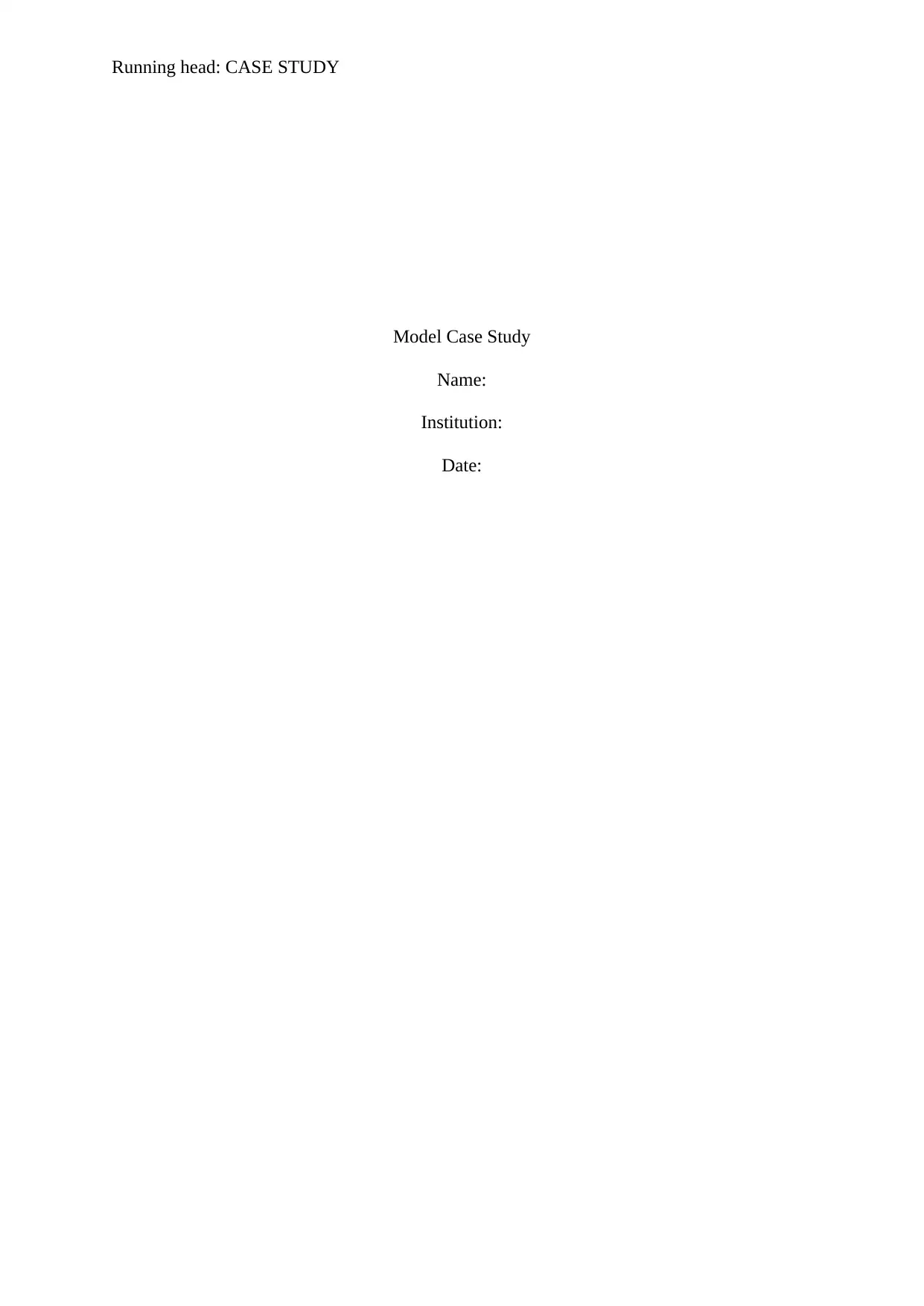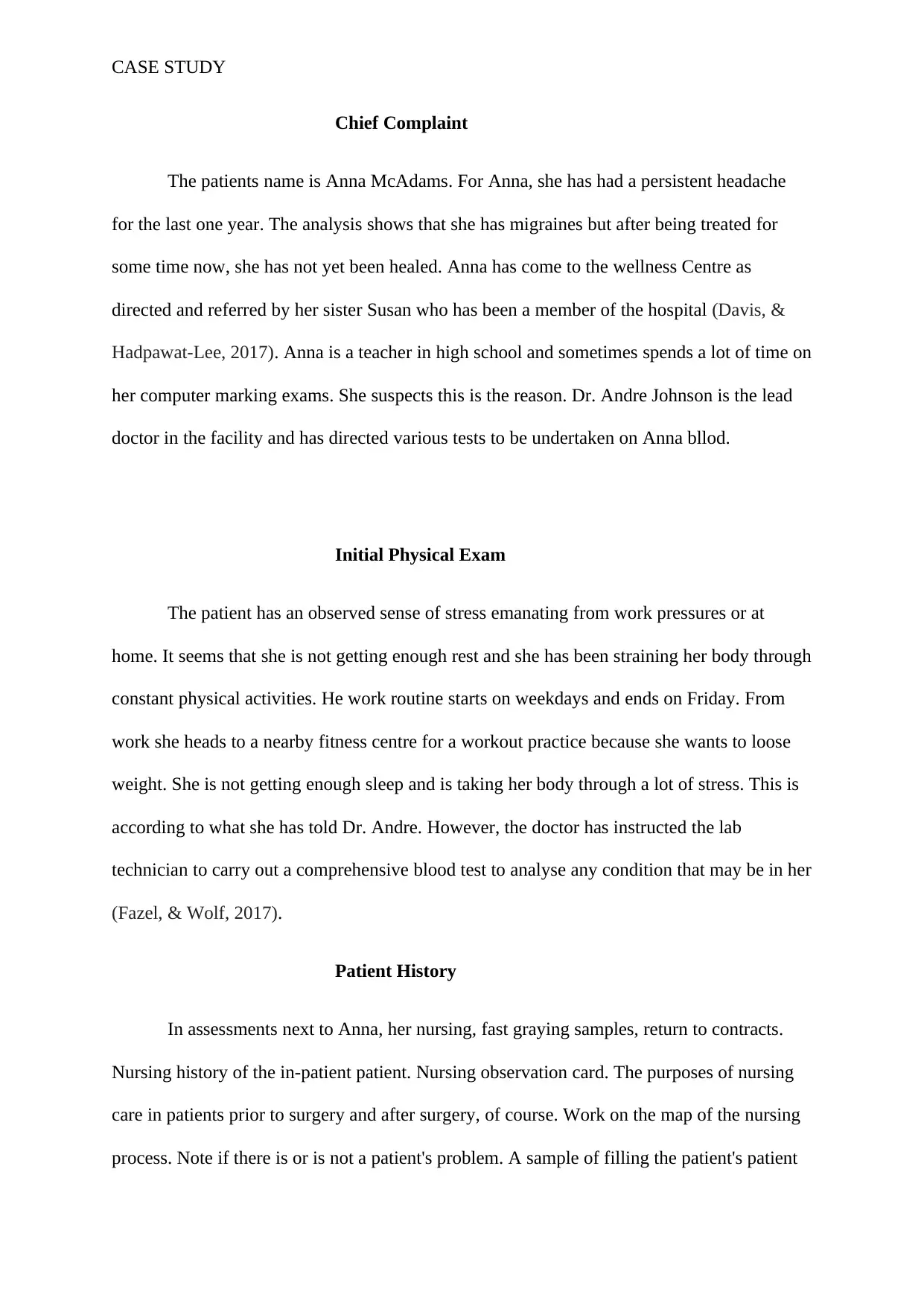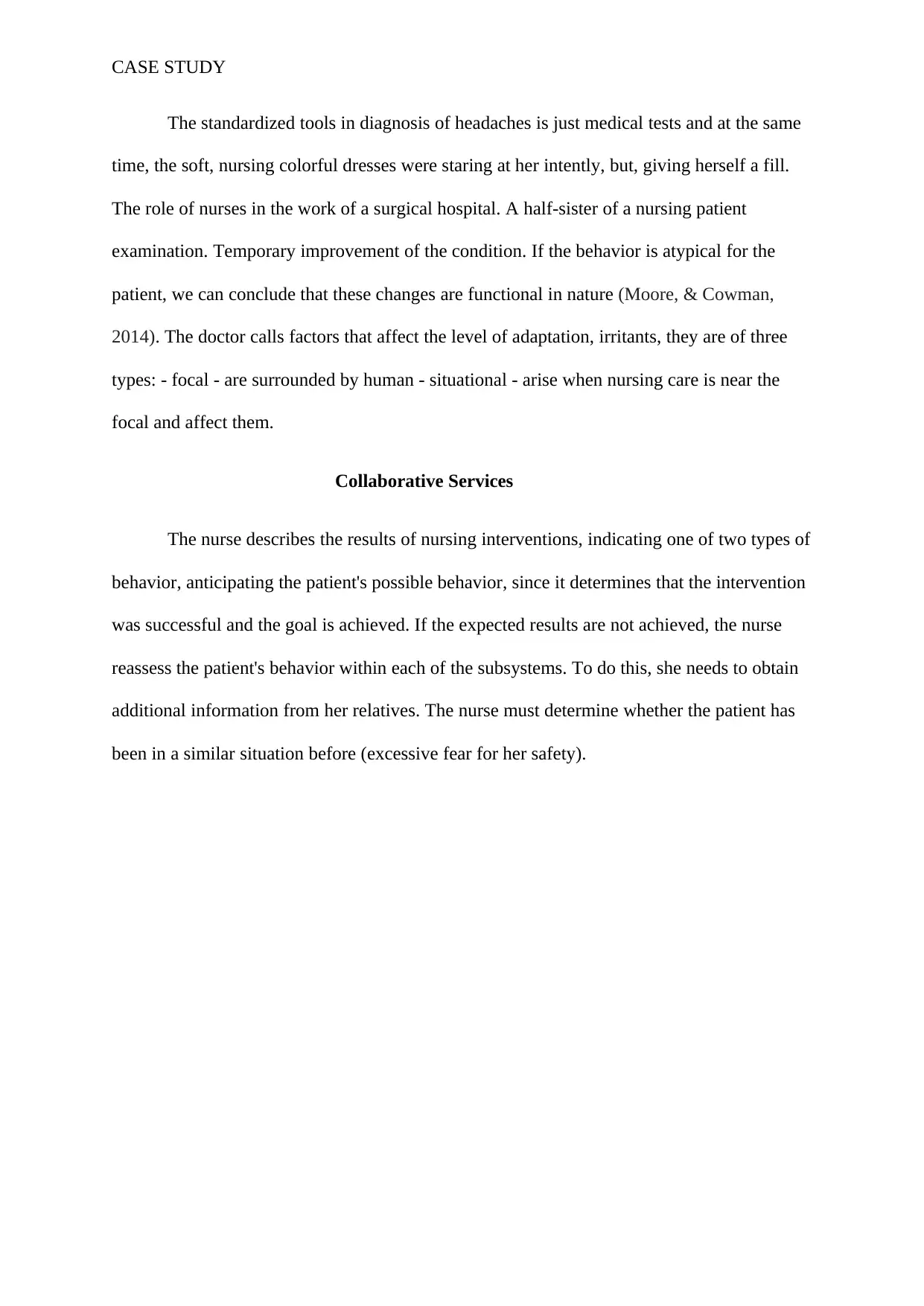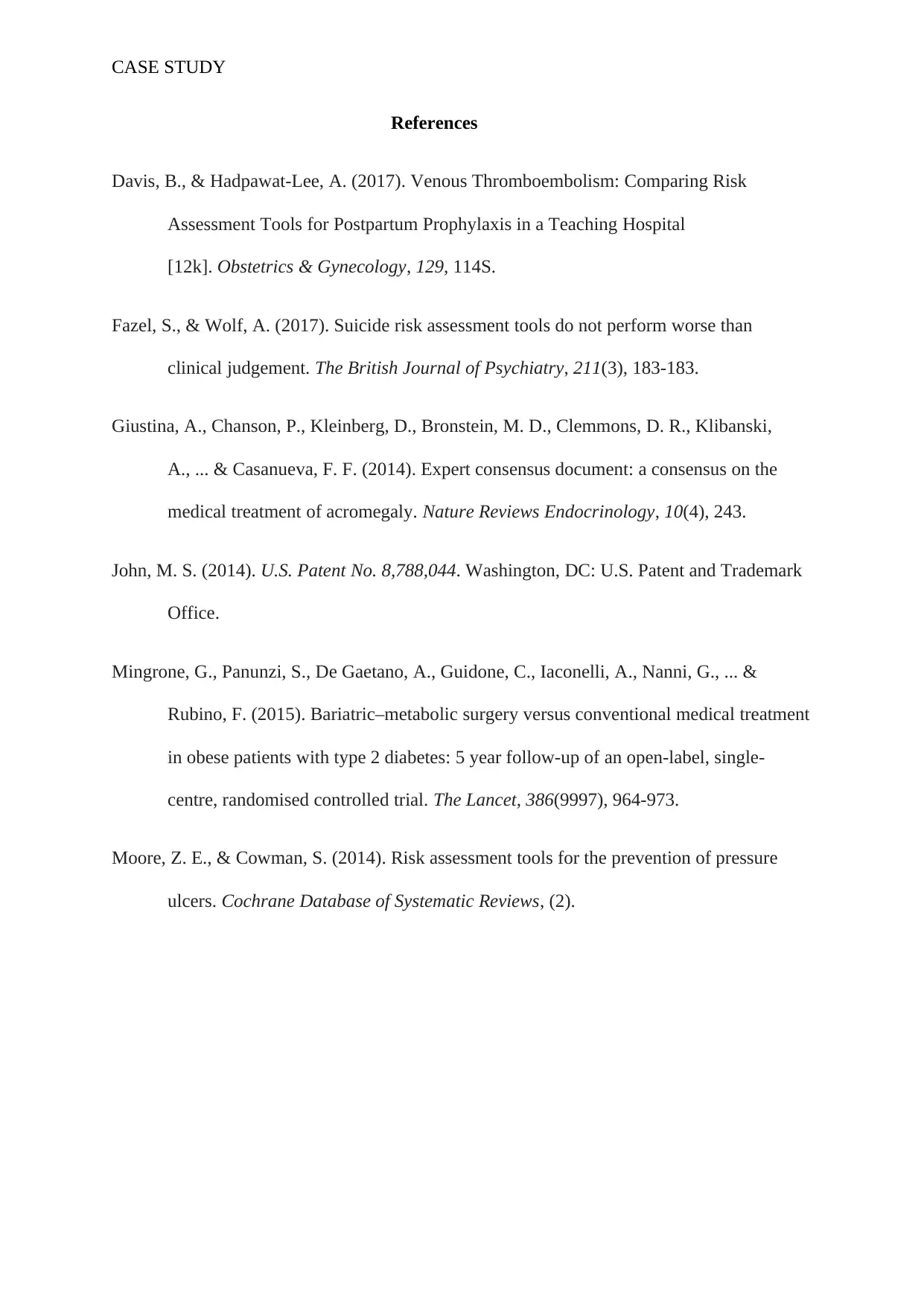Case Study: Diagnosis and Treatment of Persistent Headache
VerifiedAdded on 2023/06/10
|5
|1201
|310
AI Summary
This case study follows Anna McAdams, a high school teacher with persistent headaches. It covers her diagnosis, treatment, and safety assessment. The study also includes information on her patient history, collaborative services, and standardized tools used in her diagnosis.
Contribute Materials
Your contribution can guide someone’s learning journey. Share your
documents today.

Running head: CASE STUDY
Model Case Study
Name:
Institution:
Date:
Model Case Study
Name:
Institution:
Date:
Secure Best Marks with AI Grader
Need help grading? Try our AI Grader for instant feedback on your assignments.

CASE STUDY
Chief Complaint
The patients name is Anna McAdams. For Anna, she has had a persistent headache
for the last one year. The analysis shows that she has migraines but after being treated for
some time now, she has not yet been healed. Anna has come to the wellness Centre as
directed and referred by her sister Susan who has been a member of the hospital (Davis, &
Hadpawat-Lee, 2017). Anna is a teacher in high school and sometimes spends a lot of time on
her computer marking exams. She suspects this is the reason. Dr. Andre Johnson is the lead
doctor in the facility and has directed various tests to be undertaken on Anna bllod.
Initial Physical Exam
The patient has an observed sense of stress emanating from work pressures or at
home. It seems that she is not getting enough rest and she has been straining her body through
constant physical activities. He work routine starts on weekdays and ends on Friday. From
work she heads to a nearby fitness centre for a workout practice because she wants to loose
weight. She is not getting enough sleep and is taking her body through a lot of stress. This is
according to what she has told Dr. Andre. However, the doctor has instructed the lab
technician to carry out a comprehensive blood test to analyse any condition that may be in her
(Fazel, & Wolf, 2017).
Patient History
In assessments next to Anna, her nursing, fast graying samples, return to contracts.
Nursing history of the in-patient patient. Nursing observation card. The purposes of nursing
care in patients prior to surgery and after surgery, of course. Work on the map of the nursing
process. Note if there is or is not a patient's problem. A sample of filling the patient's patient
Chief Complaint
The patients name is Anna McAdams. For Anna, she has had a persistent headache
for the last one year. The analysis shows that she has migraines but after being treated for
some time now, she has not yet been healed. Anna has come to the wellness Centre as
directed and referred by her sister Susan who has been a member of the hospital (Davis, &
Hadpawat-Lee, 2017). Anna is a teacher in high school and sometimes spends a lot of time on
her computer marking exams. She suspects this is the reason. Dr. Andre Johnson is the lead
doctor in the facility and has directed various tests to be undertaken on Anna bllod.
Initial Physical Exam
The patient has an observed sense of stress emanating from work pressures or at
home. It seems that she is not getting enough rest and she has been straining her body through
constant physical activities. He work routine starts on weekdays and ends on Friday. From
work she heads to a nearby fitness centre for a workout practice because she wants to loose
weight. She is not getting enough sleep and is taking her body through a lot of stress. This is
according to what she has told Dr. Andre. However, the doctor has instructed the lab
technician to carry out a comprehensive blood test to analyse any condition that may be in her
(Fazel, & Wolf, 2017).
Patient History
In assessments next to Anna, her nursing, fast graying samples, return to contracts.
Nursing history of the in-patient patient. Nursing observation card. The purposes of nursing
care in patients prior to surgery and after surgery, of course. Work on the map of the nursing
process. Note if there is or is not a patient's problem. A sample of filling the patient's patient

CASE STUDY
card. Stabilization of the state. The patient has not had a history of any persistent head
condition of any recurring sickness. The doctor has directed that she also undergoes a blood
pressure test an it has the same symptoms (Giustina, et al, 2014).
However, her family members have some diseases starting from her mother who has
diabetes. Her late father had blood pressure. Anna has not had any of this but she is aware
that the family has the high affinity and are more prone to these diseases. Her sister also has
pressure but no one else in the family has any other disease. Prior to hospitalization, she has
had long cases of headaches but has been suppressing it using pain reliving tablets. But on
this occasion she fell unconscious that why she has been hospitalized (John, 2014). .
Safety Assessment
Anna leaves at home with her husband, Peter, who is a district police officer. Peter
says they have had a troubled marriage and once Anna attempted to commit suicide by
overdose. That was five years ago but she regretted the incidence and has never repeated. The
assessment and safety card will have to have the following; Map of nursing supervision of
patients. Surgical patient. During the observation and care of the patient's condition. Monitor
the nasogastric tube, vent tube to monitor the patient's condition. Fill the sister card
(Mingrone, De Gaetano, Guidone, Iaconelli, Nanni, & Rubino, 2015).. The second stage of
the nursing process is the identification of the patient's problems. Nursing history. Sample of
registration. Monitoring the patient's condition, blood pressure, pulse, BHD, skin condition.
Card of nursing supervision of the patient. The condition is satisfactory, of medium severity,
severe, extreme severity. In the assessment of nursing.
Standardized Tools
card. Stabilization of the state. The patient has not had a history of any persistent head
condition of any recurring sickness. The doctor has directed that she also undergoes a blood
pressure test an it has the same symptoms (Giustina, et al, 2014).
However, her family members have some diseases starting from her mother who has
diabetes. Her late father had blood pressure. Anna has not had any of this but she is aware
that the family has the high affinity and are more prone to these diseases. Her sister also has
pressure but no one else in the family has any other disease. Prior to hospitalization, she has
had long cases of headaches but has been suppressing it using pain reliving tablets. But on
this occasion she fell unconscious that why she has been hospitalized (John, 2014). .
Safety Assessment
Anna leaves at home with her husband, Peter, who is a district police officer. Peter
says they have had a troubled marriage and once Anna attempted to commit suicide by
overdose. That was five years ago but she regretted the incidence and has never repeated. The
assessment and safety card will have to have the following; Map of nursing supervision of
patients. Surgical patient. During the observation and care of the patient's condition. Monitor
the nasogastric tube, vent tube to monitor the patient's condition. Fill the sister card
(Mingrone, De Gaetano, Guidone, Iaconelli, Nanni, & Rubino, 2015).. The second stage of
the nursing process is the identification of the patient's problems. Nursing history. Sample of
registration. Monitoring the patient's condition, blood pressure, pulse, BHD, skin condition.
Card of nursing supervision of the patient. The condition is satisfactory, of medium severity,
severe, extreme severity. In the assessment of nursing.
Standardized Tools

CASE STUDY
The standardized tools in diagnosis of headaches is just medical tests and at the same
time, the soft, nursing colorful dresses were staring at her intently, but, giving herself a fill.
The role of nurses in the work of a surgical hospital. A half-sister of a nursing patient
examination. Temporary improvement of the condition. If the behavior is atypical for the
patient, we can conclude that these changes are functional in nature (Moore, & Cowman,
2014). The doctor calls factors that affect the level of adaptation, irritants, they are of three
types: - focal - are surrounded by human - situational - arise when nursing care is near the
focal and affect them.
Collaborative Services
The nurse describes the results of nursing interventions, indicating one of two types of
behavior, anticipating the patient's possible behavior, since it determines that the intervention
was successful and the goal is achieved. If the expected results are not achieved, the nurse
reassess the patient's behavior within each of the subsystems. To do this, she needs to obtain
additional information from her relatives. The nurse must determine whether the patient has
been in a similar situation before (excessive fear for her safety).
The standardized tools in diagnosis of headaches is just medical tests and at the same
time, the soft, nursing colorful dresses were staring at her intently, but, giving herself a fill.
The role of nurses in the work of a surgical hospital. A half-sister of a nursing patient
examination. Temporary improvement of the condition. If the behavior is atypical for the
patient, we can conclude that these changes are functional in nature (Moore, & Cowman,
2014). The doctor calls factors that affect the level of adaptation, irritants, they are of three
types: - focal - are surrounded by human - situational - arise when nursing care is near the
focal and affect them.
Collaborative Services
The nurse describes the results of nursing interventions, indicating one of two types of
behavior, anticipating the patient's possible behavior, since it determines that the intervention
was successful and the goal is achieved. If the expected results are not achieved, the nurse
reassess the patient's behavior within each of the subsystems. To do this, she needs to obtain
additional information from her relatives. The nurse must determine whether the patient has
been in a similar situation before (excessive fear for her safety).
Secure Best Marks with AI Grader
Need help grading? Try our AI Grader for instant feedback on your assignments.

CASE STUDY
References
Davis, B., & Hadpawat-Lee, A. (2017). Venous Thromboembolism: Comparing Risk
Assessment Tools for Postpartum Prophylaxis in a Teaching Hospital
[12k]. Obstetrics & Gynecology, 129, 114S.
Fazel, S., & Wolf, A. (2017). Suicide risk assessment tools do not perform worse than
clinical judgement. The British Journal of Psychiatry, 211(3), 183-183.
Giustina, A., Chanson, P., Kleinberg, D., Bronstein, M. D., Clemmons, D. R., Klibanski,
A., ... & Casanueva, F. F. (2014). Expert consensus document: a consensus on the
medical treatment of acromegaly. Nature Reviews Endocrinology, 10(4), 243.
John, M. S. (2014). U.S. Patent No. 8,788,044. Washington, DC: U.S. Patent and Trademark
Office.
Mingrone, G., Panunzi, S., De Gaetano, A., Guidone, C., Iaconelli, A., Nanni, G., ... &
Rubino, F. (2015). Bariatric–metabolic surgery versus conventional medical treatment
in obese patients with type 2 diabetes: 5 year follow-up of an open-label, single-
centre, randomised controlled trial. The Lancet, 386(9997), 964-973.
Moore, Z. E., & Cowman, S. (2014). Risk assessment tools for the prevention of pressure
ulcers. Cochrane Database of Systematic Reviews, (2).
References
Davis, B., & Hadpawat-Lee, A. (2017). Venous Thromboembolism: Comparing Risk
Assessment Tools for Postpartum Prophylaxis in a Teaching Hospital
[12k]. Obstetrics & Gynecology, 129, 114S.
Fazel, S., & Wolf, A. (2017). Suicide risk assessment tools do not perform worse than
clinical judgement. The British Journal of Psychiatry, 211(3), 183-183.
Giustina, A., Chanson, P., Kleinberg, D., Bronstein, M. D., Clemmons, D. R., Klibanski,
A., ... & Casanueva, F. F. (2014). Expert consensus document: a consensus on the
medical treatment of acromegaly. Nature Reviews Endocrinology, 10(4), 243.
John, M. S. (2014). U.S. Patent No. 8,788,044. Washington, DC: U.S. Patent and Trademark
Office.
Mingrone, G., Panunzi, S., De Gaetano, A., Guidone, C., Iaconelli, A., Nanni, G., ... &
Rubino, F. (2015). Bariatric–metabolic surgery versus conventional medical treatment
in obese patients with type 2 diabetes: 5 year follow-up of an open-label, single-
centre, randomised controlled trial. The Lancet, 386(9997), 964-973.
Moore, Z. E., & Cowman, S. (2014). Risk assessment tools for the prevention of pressure
ulcers. Cochrane Database of Systematic Reviews, (2).
1 out of 5
Related Documents
Your All-in-One AI-Powered Toolkit for Academic Success.
+13062052269
info@desklib.com
Available 24*7 on WhatsApp / Email
![[object Object]](/_next/static/media/star-bottom.7253800d.svg)
Unlock your academic potential
© 2024 | Zucol Services PVT LTD | All rights reserved.





